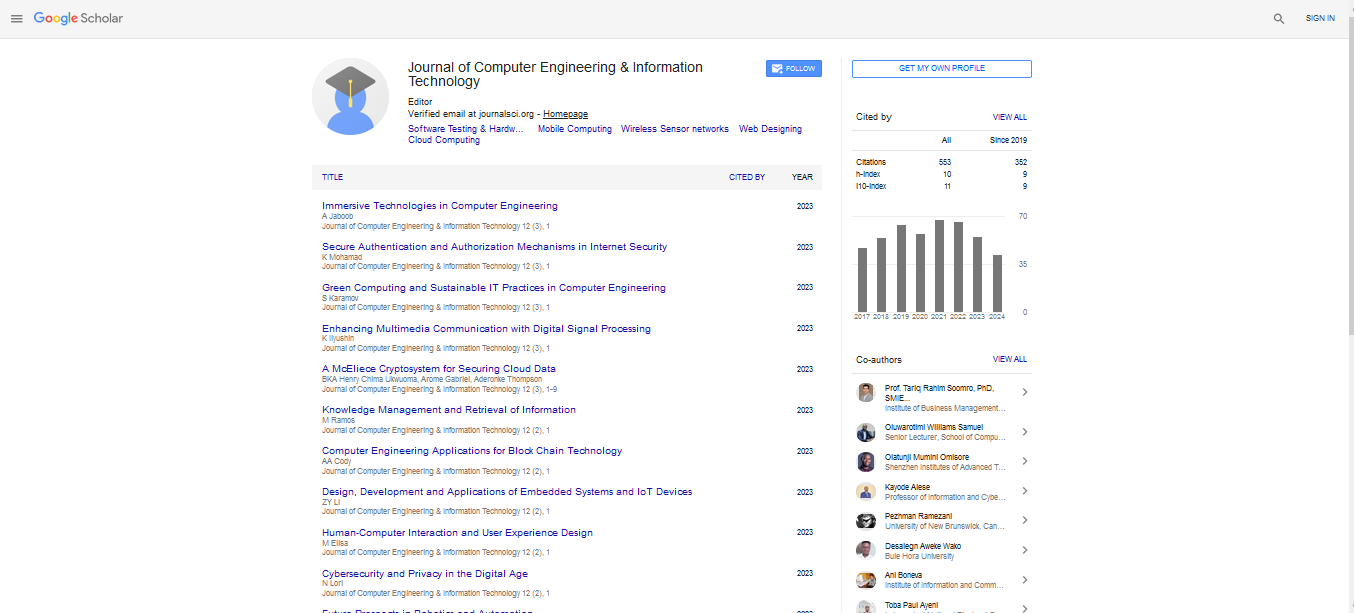Editorial, Jceit Vol: 14 Issue: 2
Human-Robot Interaction: Shaping the Future of Collaboration
Carlos Praker*
Centre for Automation and Robotics, Universidad Politécnica de Madrid, Spain
- *Corresponding Author:
- Carlos Praker
Centre for Automation and Robotics, Universidad Politécnica de Madrid, Spain
E-mail: parker_carlos@gmail.com
Received: 01-March-2025, Manuscript No jceit-25-169325; Editor assigned: 4-March-2025, Pre-QC No. jceit-25-169325 (PQ); Reviewed: 20-March-2025, QC No jceit-25-169325; Revised: 27-March-2025, Manuscript No. jceit-25-169325 (R); Published: 31-March-2025, DOI: 10.4172/2324-9307.1000346
Citation: Carlos P (2025) Human-Robot Interaction: Shaping the Future of Collaboration. J Comput Eng Inf Technol 14: 346
Introduction
As robotics technology rapidly evolves, the interaction between humans and robots has become a critical area of research and innovation. Human-Robot Interaction (HRI) is an interdisciplinary field that focuses on understanding, designing, and evaluating robotic systems for use by or with humans. It combines elements from robotics, human-computer interaction, artificial intelligence [1], psychology, and cognitive science. The ultimate goal is to create robots that can seamlessly cooperate with humans in environments ranging from industrial settings and healthcare facilities to households and public spaces.
The Importance of Human-Robot Interaction
Robots are no longer confined to controlled environments like manufacturing plants. They are increasingly being deployed in dynamic human-centric environments, such as hospitals, schools, homes, and even battlefields. This shift necessitates the development of intuitive and safe interfaces that allow effective interaction between humans and robots.
Key elements of HRI include:
- Communication â?? Robots must understand human language, gestures, emotions, and commands, while also being able to express themselves clearly [2].
- Trust and Acceptance â?? Human users must feel safe and confident working with robots. This involves transparency in robot behavior and predictable actions.
- Collaboration â?? Robots must function as teammates or assistants rather than mere tools, capable of adapting to human workflows and social dynamics.
Applications of HRI
HRI has a wide range of applications across various industries:
- Healthcare: Robots assist with surgery, rehabilitation, and elder care. For example, social robots like PARO are used to comfort patients with dementia.
- Education: Robots can act as tutors or companions to enhance student engagement and personalize learning experiences.
- Manufacturing: Collaborative robots (cobots) work alongside human workers, increasing productivity and reducing workplace injuries [3].
- Search and Rescue: In disaster scenarios, robots can assist in locating survivors, with human operators guiding them remotely.
- Domestic Assistance: Home robots such as robotic vacuum cleaners and personal assistants like Jibo are designed to integrate into daily life [4].
Challenges in Human-Robot Interaction
Despite its promise, HRI faces several challenges:
- Technical limitations: Understanding natural language and context remains a difficult task for robots. Sensory and perceptual systems also need further advancement.
- Ethical and Privacy Concerns: The use of robots in sensitive areas raises questions about data security, autonomy, and accountability.
- Social and Cultural Barriers: Cultural norms affect how people perceive and interact with robots. Designers must consider cultural context to ensure broad acceptance.
Future Directions
The future of HRI lies in creating robots that are not only functional but also socially intelligent. Advances in machine learning, affective computing, and cognitive modeling will allow robots to better understand human emotions, intentions, and behaviors [5]. Additionally, greater emphasis will be placed on co-design, where end-users are involved in shaping robot behavior and interfaces, ensuring relevance and usability. Ethical frameworks and regulations will also play a crucial role in guiding responsible development and deployment.
Conclusion
Human-Robot Interaction is at the forefront of technological innovation, bridging the gap between artificial intelligence and human-centered design. As robots become more prevalent in society, the need for effective, ethical, and empathetic interaction becomes increasingly vital. The continued collaboration among engineers, designers, psychologists, and end-users will be essential in shaping a future where humans and robots can work together harmoniously and safely.
References
- Goodrich MA, Schultz AC (2007) Humanâ??robot interaction: a survey. Foundations and Trends® in Humanâ??Computer Interaction 1: 203â??275.
- Dautenhahn K (2007) Socially intelligent robots: Dimensions of humanâ??robot interaction. Philosophical Transactions of the Royal Society B: Biological Sciences 362: 679â??704.
- Fong T, Nourbakhsh I, Dautenhahn K (2003) A survey of socially interactive robots. Robotics and Autonomous Systems 42: 143â??166.
- Breazeal C (2003) Toward sociable robots. Robotics and Autonomous Systems 42: 167â??175.
- Bartneck C, Kulic D, Croft E, Zoghbi S (2009) Measurement instruments for the anthropomorphism, animacy, likeability, perceived intelligence, and perceived safety of robots. International Journal of Social Robotics 1: 71â??81
Indexed at, Google Scholar, Crossref
Indexed at, Google Scholar, Crossref
Indexed at, Google Scholar, Crossref
Indexed at, Google Scholar, Crossref
 Spanish
Spanish  Chinese
Chinese  Russian
Russian  German
German  French
French  Japanese
Japanese  Portuguese
Portuguese  Hindi
Hindi 